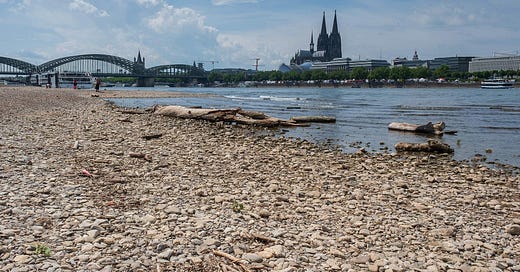Europe’s $17 Billion Gamble on Water Security
The deep fractures in how we manage shared resources.
This month, as parts of the United Kingdom experienced their driest spring since 1893, the European Investment Bank made a significant announcement. A total of €15 billion will be directed toward protecting and restoring water ecosystems across Europe. This is a strategic climate adaptation move meant to address the growing instability of water systems throughout the continent.
The initiative is ambitious in both scale and intent. Alongside projects to modernize wastewater treatment and drinking water infrastructure, it includes funding for nature-based solutions. These include efforts like wetland restoration, river re-naturalization, and stormwater management systems that aim to mimic natural hydrology rather than forcing water to conform to rigid, outdated infrastructure. There’s a clear shift here, from controlling water to learning how to live with it.
What’s most striking, though, is the timing. Europe has long benefited from relatively predictable water cycles, especially compared to other regions more regularly shaped by monsoon patterns or seasonal droughts. But that assumption is breaking down. Climate data from the past five years tells a clear story: rainfall is more sporadic, snowmelt is arriving too early or too fast, and aquifers are not recovering between dry seasons.
This makes the EIB’s investment more than a financial announcement. It’s a public acknowledgment that Europe’s water security is under threat. And like many climate-related risks, it’s one that builds slowly until it suddenly becomes urgent.
Still, money alone doesn’t fix broken systems. The key question now is how the funding will be allocated. Will it be channeled through traditional top-down institutions that already struggle with accountability and outdated technology? Or will it reach the local and regional actors who are more closely connected to watershed realities? There’s also the matter of time. Investments in ecological restoration or infrastructure modernization don’t yield results overnight. Are policymakers prepared to wait, to follow through, and to support these projects beyond the political cycle?
Across the Channel, the UK is confronting its own version of this dilemma. This spring’s drought has exposed serious failures in its utility sector, especially among private water companies. Thames Water, in particular, has come under scrutiny for ongoing pollution incidents, prompting regulators to block executive bonuses. These developments are more than headlines. They reveal the tension between water as a public good and water as a profit-generating service.
If Europe’s €15 billion package ends up reinforcing the same corporate structures without demanding change, then it risks becoming a patch rather than a pathway.
There’s also a critical gap in many existing systems that’s harder to quantify but just as important. Much of the infrastructure in use today, from treatment plants to sensors, was not built to handle the types of contaminants or variability we now face. For example, legacy plants often fail to detect and remove substances like PFAS, pharmaceuticals, and microplastics, many of which become more concentrated during droughts. Without meaningful upgrades in monitoring and data analytics, even the best-intentioned investments could miss the mark.
But it’s not all cautionary. Europe remains one of the few regions where environmental regulations still carry serious weight. The revised Urban Waste Water Treatment Directive, for instance, will require the removal of micropollutants from sewage effluents across the EU. Combined with this new investment package, there’s potential to rethink how we design and manage water systems starting with the understanding that clean water is not infinite, not free, and not guaranteed.
Financial institutions like the EIB play a critical role in shaping this future. When the Bank puts €15 billion on the table, it sends a signal not just to cities and ministries, but to industries and investors. It shifts the conversation from crisis response to systemic planning. It tells us that water is no longer just an environmental issue or a utility service. It’s a central thread in how we adapt to climate volatility.
Of course, policy and planning are only half of the story. The deeper challenge is cultural. In many parts of Europe, water infrastructure is buried underground and out of mind. It’s designed to be invisible. That invisibility has allowed decades of neglect to accumulate. Bringing water back into the public conversation making it visible, valued, and politically relevant is arguably the more difficult task.
As someone who works at the intersection of science and policy, I see this moment as a turning point. Not because of the money itself, but because of what it represents. It’s a test. Can Europe move beyond short-term fixes and start building long-term resilience? Can it treat water not as a line item, but as a foundation for every other climate adaptation effort?
The years ahead will bring more extreme weather, not less. More strain on aquifers, not less. More conflict between ecological needs and human demand. Whether this investment succeeds will depend on whether we understand that truth and act on it.
There’s a saying in water policy circles: All solutions are local. But the urgency is now global. If the EU’s €15 billion commitment is used wisely, with patience and vision, it could be the start of a more grounded, more resilient relationship between society and water.
If it isn’t, we will soon discover that no amount of emergency spending can substitute for preparation, and that the cost of waiting is always paid in thirst.
Link: https://www.reuters.com/sustainability/climate-energy/eib-commits-15-billion-euros-protect-eus-water-resources-2025-06-04/




